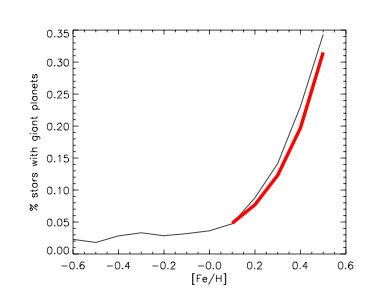Two recent observational facts have mitigated the evidence of the correlation between metallicity and the probability of detection of exo-planets : (a) the first is that, contrary to dwarfs, giant and ’massive’ stars which were found to have an orbiting exoplanet do not show an overabundance of heavy elements. (b) the second is that at [Fe/H]<-0.2 dex, for moderately deficient stars, more planets are being detected on stars of the thick disk population than on thin disk (Haywood 2008 A&A, 482, 673) objects, here again breaking down the correlation between metallicity and planets. We show in a recent article (Haywood 2009) that these two pecularities can be explained if the planet-metallicity correlation is given a radically different interpretation. In the last years, radial mixing has proved to be a phenomenon of importance in the galactic disk. Radial mixing is a consequence of badly identified dynamical processes, which are responsible for the ’migration’ of stars in the disk. Stars born in the inner parts of the disk may drift to the outer parts within a few billion years, and vice-versa. The inner disk evolving at a more rapid pace, stars born in these regions are, in the mean, more metal-rich than those born in the outer disk. Radial mixing then provides a natural explanation to point (a) and (b). Indeed, giants and massive stars are in the mean younger than dwarfs. Radial mixing being a secular process, its effects are proportional to time. Hence, samples containing older objects are more polluted by wanderers from the inner disk. It is also possible to explain point (b) above, because if thick disk stars are deficient in metals, their origin is also thought to be local or in the inner disk, i.e very different from the thin disk stars of the same metallicity. All this suggest that, rather than metallicity, it is the distance to the galactic center that governs the rate of Jupiters. The new question is then : what is the cause of this dependence ? A interesting candidate is the density of H2 gas. Molecular hydrogen is indeed the main ingredient of circumstellar disks and Jupiters. 70% of galactic H2 resides within the solar galactocentric radius. Its density rises towards the inner disk to reach a maximum at 3-5 kpc from the Sun (the molecular ring), at 4 to 5 times the estimated local density, in proportion to the rate of exoplanets on local stars (4%) and metal-rich ones (25%).

On the correlation between metallicity and the presence of giant planets Haywood M. ApJ Letter, 698, L1

